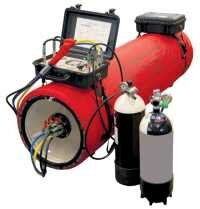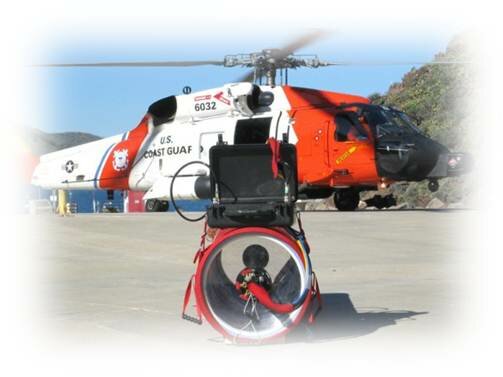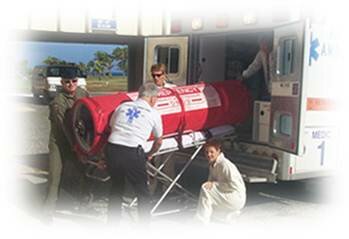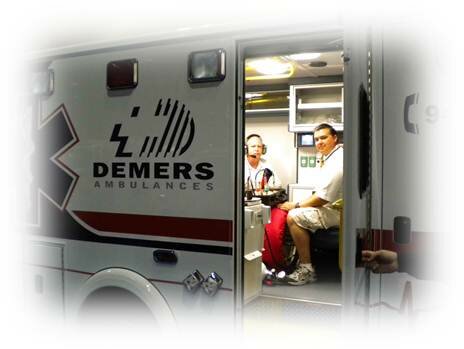Portable Hyperbaric Chambers

Portable hyperbaric chambers are folding portable pressure vessels suitable for the pressurization and transport under pressure of a person requiring hyperbaric oxygen therapy (HBOT). A portable hyperbaric chamber, that provides immediate treatment for different medical conditions, by supplying 100% oxygen to the patient at above atmospheric pressures, whilst being transported to a medical facility.
Portable chamber SOS Hyperlite is compact and can be easily stored for almost immediate use, when no other hyperbaric facility is available onsite, or the existing equipment is in use treating other patients. Being so portable, and not requiring installation, portable hyperbaric chambers can be used anywhere in the building away from busy areas, to isolation bays if necessary, simply by pushing it around on a hospital trolley.
Today there is an ever-growing necessity to use more aggressive and pathophysiologically adequate techniques of emergency and intensive care in the early stages of natural disasters as well as terrorist acts, battlefields, modern bombing or blast injuries.
The practice of the last decades shows that these impairments determine the fatal outcome for many severely injured victims already in the pre-hospitalization stage, but also in the initial hospitalization stage, during emergency and intensive care by the methods conventionally used for such cases. In cases of inadequate or late anti-hypoxic therapy, the increasing or persistent acute oxygen deficit is the basis for the subsequent acute organ and systemic damage in the post-shock period (SIRS, ARDS, multi-organ failure, etc.).
Data presented in many scientific papers related to trauma and battlefield medicine provide a justification for intensified research of hyperbaric oxygen therapy for blast/blunt injuries, traumatic brain injuries (TBI), and for the much wider application for these purposes of mobile portable hyperbaric chambers, designed not only for military/field use, but, in todays circumstances, also for inner-city use.
Having a portable hyperbaric chamber on site at a hospital or medical center adds flexibility to the treatment protocols available in certain situations. Monoplace and Multiplace Hyperbaric chambers are normally large and immobile.
Portable Hyperbaric Chambers On Ambulances
Carbon Monoxide Poisoning is the most common form of injury and death due to poisoning worldwide. It has been estimated that more than 40,000 people per year seek help as a result of Carbon Monoxide Poisoning.
Smoke inhalation is the cause of significantly more than this with 3,900 people died from exposure to fire, flame, and smoke in the United States in 2001. Treatment of poisoning involves administering hyperbaric oxygen therapy as soon as possible. As is usually the case, there is no hyperbaric chamber when and where it is most needed. Without treatment, the half-life of carboxyhemoglobin is four to six hours. Through HBO therapy, the effective half-life of carboxyhemoglobin can be decreased to 22 minutes. The presence and use of a portable hyperbaric chamber to provide immediate on the scene treatment is now a reality. Early treatment leads to rapid recovery, a therapy that can continue whilst the patient is being taken to the nearest medical centre. Delay, and the consequences may have become far more serious, even fatal.
Portable Hyperbaric Chambers For Fire Fighters And Miners
Fire fighters and miners expose themselves to CO far more regularly than the average individual due to the closed space environments in which they operate. This causes an increased risk for Cardiovascular Disease and Premature Death due to CO exposure according to the New England Journal of Medicine. The USFA announced that 11.3% of firefighter deaths in 1999-2000 were related to poisoning or asphyxiation and The New England Journal of Medicine, (Volume 356:2535-2537) demonstrated strong correlation between CO poisoning and coronary heart disease and mortality in firefighters.
Regular HBO Treatment would significantly reduce the levels of CO that remain in the body causing irreparable damage. A portable hyperbaric chamber would provide fire fighters with the added capability of receiving regular doses of HBO therapy in the comfort of their own Fire Station. Full Medical Technician (DMT) or Emergency Medical Technician (EMT) training can be provided for operation of the system.
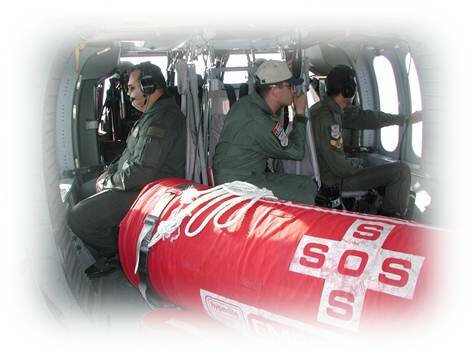
Photo courtesy of SOS Hyperlite Ltd.
Hyperbaric Oxygen Therapy is the preferred treatment for both CO poisoning and smoke inhalation, but as is usually the case, there is no hyperbaric chamber when and where it is most needed. The presence and use of a Hyperlite to provide immediate on the scene treatment is now a reality. Early treatment leads to rapid recovery, a therapy that can continue whilst the patient is being taken to the nearest medical center. Delay and the consequences may have become far more serious, even fatal.
In Australia, a number of States have battled to control major wild fires. Once again, smoke inhalation has been a major problem. The country has always led the way in air-ambulance services and the words Flying Doctor is still associated with the Australian bush conjuring up the picture of the isolated rancher sitting by his radio and waiting for the latest medical advice update or estimated time of arrival of the aircraft. But even this sterling service could not entirely cope with the recent wild fire devastation and Australian Defense Forces had to be called in to assist local emergency services in many areas.
In the United States, similar fast moving and deadly wildfires ripped California apart and in Greece, thousands of acres of land, homes, businesses, crops & livestock were lost in a charcoal hell of fire. Portable hyperbaric chamber is ideal for use by air ambulances (fixed wing or helicopter) to provide instant medical first response to trauma & injury on site and then - continued treatment during transportation of the patient.
In Emergency Scenarios More Akin To Silent Movies...
In the smoking ruins of a city following an earthquake or volcanic eruption, during a wild fire or following a terrorist attack, theres one factor that is paramount in saving lives: the speed by which first responders can deliver effective medical treatment to casualties. Its the age old story suffer major trauma in a remote mountain region and statistically, your chances of survival are far less than someone who receives similar injuries outside the front door of a citys emergency trauma center.
Mind you, Ive seen response to emergency scenarios more akin to silent movies such as the Keystone Cops where C&C (Command & Control) is soon replaced by Chaos & Confusion. The terrorist bomb detonates in the crowded city center: everyone dials the emergency number at once from a hundred mobile phones. Fifty ambulances rush to the incident causing their own traffic jam and inevitable delays. Soon after their arrival jammed into every tiny side street a second device blows up in another location 2 miles away.
Ambulances cant move: nobody is quite sure which ambulance should go where (even if they could move) or they all end up returning to the nearest hospital while three or four other major trauma centers remain empty. Such a scenario easily happens. The idea that the ambulance can arrive with a portable hyperbaric chamber on board must be a clear step in the right direction.
The patient suffering from blast injuries, blood loss, Carbon Monoxide Poisoning or smoke inhalation can be immediately treated and whats more if the ambulances departure to or arrival at the citys trauma center is delayed for any reason the casualty can continue to receive effective treatment that might be the difference between life & death.
